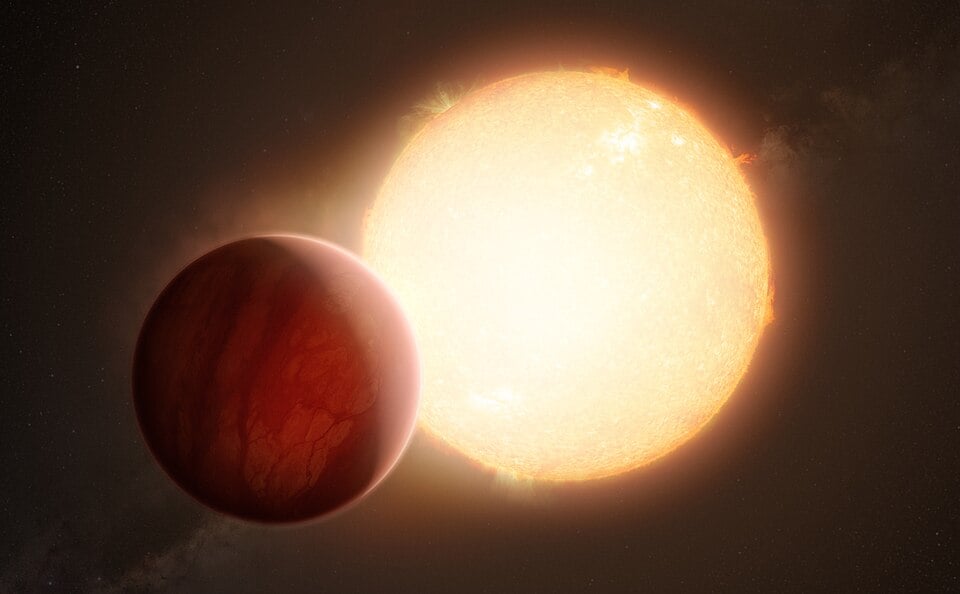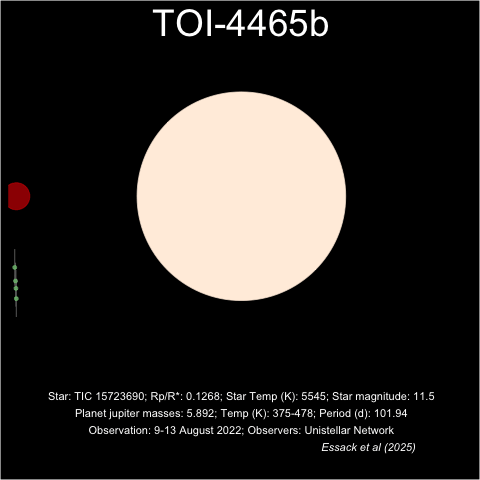Distant exoplanets can be dodgy to spot even in the best of observations. Despite the challenges, a team of astronomers just reported the discovery of a gas giant exoplanet that lies about 400 light-years from Earth. It's called TOI-4465 b and it takes 12 hours to transit across the face of its star during its 102-day orbit.
TOI-4465 b was actually first observed by the Transiting Exoplanet Survey Satellite (TESS) and reported as a transit event. A transit is when the object being observed crosses in front of its star from our point of view here at Earth. That means the planet has to be in just the right orbit to be seen. In addition, other objects can also transit stars (such as small black holes). So, just seeing it transit wasn't enough to confirm TOI-4465 b as a planet. Astronomers needed to see it transit more than once to make sure it just wasn't a one-time wiggle in the data.
Due to its lengthy orbit, astronomers only get three chances each year to observe TOI-4465 b, and those windows are challenging, according to Zahra Essack of the University of New Mexico. She led a team project focused on this gas giant planet. “The observational windows are extremely limited. Each transit lasts about 12 hours, but it is incredibly rare to get 12 full hours of dark, clear skies in one location,” she said. “The difficulty of observing the transit is compounded by weather, telescope availability, and the need for continuous coverage.”
What Is TOI-4465 b?
This gas giant exoplanet is part of the population of distant worlds that lie in the size range of our own Jupiter. It's actually about 25% larger in radius and has about six times Jupiter's mass packed inside. Interestingly, this massive, dense world is pretty temperate as big Jupiters go—its temperature ranges from 375–478 K (about 200–400°F).
TOI-4465's size and moderate temperatures put it in a rare class of Jupiter-type planets. It bridges the gap between the really hot Jupiters, most of which orbit extremely close to their stars in very short (around 10 days or less) orbits and our own cold Jupiter (which orbits the Sun in 11.8 years). The 102-day orbit would put TOI-4465 b somewhere between Mercury and Venus if this planet were in our own Solar System. This size, orbit, and lower temperature make the planet a great target for future observations, particularly by JWST, which could also study its atmosphere in some detail.
 An artist's impression of a hot Jupiter orbiting close to its star. It's about to transit in front of its star, and in the process, will block out a tiny bit of the light. TESS and other transit-measuring instruments can detect that light blockage. The length of time it takes the planet to transit gives clues to its orbit and other characteristics. Credit: ESO/M. Kornmesser
An artist's impression of a hot Jupiter orbiting close to its star. It's about to transit in front of its star, and in the process, will block out a tiny bit of the light. TESS and other transit-measuring instruments can detect that light blockage. The length of time it takes the planet to transit gives clues to its orbit and other characteristics. Credit: ESO/M. Kornmesser
“This discovery is important because long-period exoplanets (defined as having orbital periods longer than 100 days) are difficult to detect and confirm due to limited observational opportunities and resources. As a result, they are underrepresented in our current catalog of exoplanets,” explained Essack. “Studying these long-period planets gives us insights into how planetary systems form and evolve under more moderate conditions.”
Solving an Observational Problem
So, how do scientists go about observing TOI-4465 b given the challenges it poses? Essack and her team used the power of citizen science to extend the observing time around the world. The team put out a call for people with telescopes powerful enough to observe the star and its possible planet. At least 24 citizen scientists across 10 countries used their personal telescopes to track the next transit. Given their positions around the world, these citizen scientists were able to cover the 12-hour observation time needed to confirm the transit. Their data complemented additional data from professional observatories such as Palomar in California, the Whipple Observatory in Arizona, the La Silla Observatory in Chile, and many others (listed in the paper referenced here).
“The discovery and confirmation of TOI-4465 b not only expands our knowledge of planets in the far reaches of other star systems but also shows how passionate astronomy enthusiasts can play a direct role in frontier scientific research,” said Essack. "It is a great example of the power of citizen science, teamwork, and the importance of global collaboration in astronomy."
 One of the Unistellar participants in this study created a GIF of the exoplanet transit using the Unistellar data. Credit: John Pickering.
One of the Unistellar participants in this study created a GIF of the exoplanet transit using the Unistellar data. Credit: John Pickering.
Several key programs enabled this global effort, beginning with the original TESS data. Members of the TESS Follow-up Observing Program Subgroup 1 (TFOP SG1), the Unistellar Citizen Science Network (a group of amateurs and professionals who use computerized Unistellar telescopes), and the TESS Single Transit Planet Candidate (TSTPC) Working Group, led by University of New Mexico professor Diana Dragomir.
“What makes this collaboration effective is the infrastructure behind it. The Unistellar network provides standardized equipment and data processing pipelines, enabling high-quality contributions from citizen scientists. TFOP SG1 offers a global coordination framework that connects professional and amateur astronomers and observational facilities. The TSTPC Working Group, led by Professor Dragomir, brings together the detection and follow-up expertise needed for these challenging observations,” said Essack.
Citizen Science Allows Participation in Research
The idea of using amateur astronomers' telescopes to participate in scientific observations is not new. For example, in the 1980s, a team of observers around the world made up part of the International Halley Watch. It was created to get images of the comet from its first appearance in 1985 to mid-1986 from as many observers in as many parts of the world as possible. Other citizen scientist efforts cropped up, with both amateur and professional observatories working together to study such objects as variable stars, blazars, supernovae, novae, occultations, eclipses, and much more.
Today, people also get involved in other branches of science, including biology, health and medical research, ecology, and other crowdsourced research. Their participation allows scientists to get more data over longer periods of time and stretches research budgets in the process.
For More Information
Worldwide Team of Citizen Scientists Help Confirm a Tricky Exoplanet

